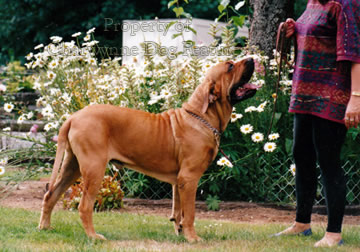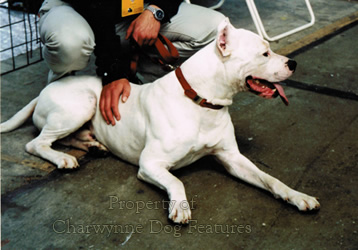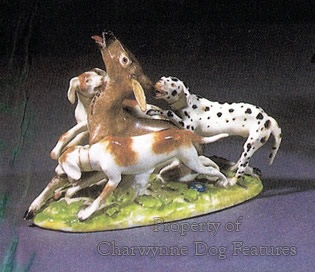957 LOOKING OUT FOR NATIONAL DOGS
LOOKING OUT FOR NATIONAL DOGS
by David Hancock
 Pride in our native breeds does not, in me, produce any resentment or opposition to foreign breeds; I admire many breeds from overseas. BREXIT for me means being more global not more insular; I am all for an individual's freedom to own the breed that appeals to him or her. We have developed so many imported breeds, breeds neglected or even ignored in their country of origin. Is the Basenji a Congolese breed or one developed here? Was the Bloodhound made into an internationally known breed by the Belgians or us? Who developed the Chow Chow into a breed? Would the Pug have survived without Dutch and British patronage? Did the rabbit dog of the Maltese islands become known as the Pharaoh Hound because of promotion from Malta? Did the Afghans make the Afghan Hound known to the world? I think not.
Pride in our native breeds does not, in me, produce any resentment or opposition to foreign breeds; I admire many breeds from overseas. BREXIT for me means being more global not more insular; I am all for an individual's freedom to own the breed that appeals to him or her. We have developed so many imported breeds, breeds neglected or even ignored in their country of origin. Is the Basenji a Congolese breed or one developed here? Was the Bloodhound made into an internationally known breed by the Belgians or us? Who developed the Chow Chow into a breed? Would the Pug have survived without Dutch and British patronage? Did the rabbit dog of the Maltese islands become known as the Pharaoh Hound because of promotion from Malta? Did the Afghans make the Afghan Hound known to the world? I think not.
Whilst I would like us to do more to safeguard the future of those native breeds slowly disappearing from the scene, I never view breeds automatically as the property of the country that claims them. So many breeds were developed in a country other than that of their origin or early appearance. Are Labradors or Newfoundlands Canadian breeds? Is the St Bernard really Swiss or the Bloodhound Belgian? When our cartoonists are poking fun at the French or the Germans they depict them as Poodles or Dachshunds; this despite the fact that the word Poodle comes from the German Pudel, which has a common origin with our word puddle. The French call the Poodle the Caniche and the Dachshund the Basset Allemand ou Teckel; in their target countries our cartoonists miss their mark. I suspect that the Great Dane became the Deutsche Dogge as a result of rising German nationalism around 1870. But I would dispute the correctness of the breed title here anyway. The Broholmer is the real great Danish dog or Dogge Danische.
I can understand too the outrage felt in both Brazil and Argentina, when their national breeds, the Fila Brasiliero and the Dogo Argentino, were proscribed in the import regulations attached to the foolish Dangerous Dogs Act. The Fila Brasiliero is probably the most temperament-tested breed in the world. The Dogo Argentino was created by a geneticist. In Japan, the Tosa is officially listed as a "National Treasure" (just as the Jindo is in South Korea); here it is listed as a national menace in the DDA itself. When I see these breeds at foreign shows, behaving immaculately with other dogs, presenting no threat to spectators and often handled by ladies, I feel nothing but contempt for the Home Office and their adviser on breeds of dog, the Kennel Club.
It is good too to see overseas countries claiming their breeds in their breed titles. The Belgian, Dutch and German Shepherd Dogs make our collie breeds both undervalued and not worth claiming. The Greenland and Iceland Dogs immediately reveal their origins. Our Pointer, Mastiff, Bulldog and Bull Terrier all lack a national adjective, unlike our Setter, Springer and Toy Terrier. I always think of the Deerhound as the Scottish Deerhound, perhaps in the mould of the Irish Wolfhound. In the light of the Dalmatian's alleged (and disputed) birthplace and knowing the tendentious nature of so much canine history, to argue against the record of print rather than recorded function and any number of depictions of that function, as a deer-hunting dog, seems specious. 
Now that the Dalmatian is considered to be a Yugoslavian (possibly updated to Croatian) breed by the FCI; its new host country will now dictate its breed standard. The Romans ruled Dalmatia without ever mentioning such strikingly-distinctive dogs. But they did mention the dogs of the Illyrians and Pannonians, and, indeed every other dog of that area worth a comment. An Adriatic coastal home for the breed has escaped every historian recording information on dogs that I am aware of. I am not at all convinced by the claims of the writer Boris Spoljakic, in his "Breeds from Croatia" published in 1993. Would any country or province creating such remarkably coated dogs not have prized them, perpetuated them and claimed them? A Serbian poet, Jurij Dalmatin (1546-1589), wrote to a Bohemian duchess to thank her for the dogs she sent him, with these words: "The interest in my Turkish dogs grows in all Serbia...these dogs are so popular that they call them by my name - Dalmatin. This new name is already more and more ingrained..." Serbia is some way from Dalmatia and the Turks made use of dogs from all over their extensive empire. I believe that the breed was well known long before the 16th century in the Balkans. I wonder if Mr Dalmatin's interest in the breed wasn't because of its early medieval name of Dama-chien or deer-dog. If so his interest in a breed of dog with a name so like his is perfectly understandable.
Having a nation in the breed title does help, as the Lapphund and Spitz breeds demonstrate. The word spitz indicates a type of dog, just as pointer, mastiff and bulldog do. Breeds need to be given precise names, as the German Pointers, the French and Majorcan Bulldogs and the Neapolitan Mastiff demonstrate. The Tibetan breeds have got their nation right but hardly their nouns; the Tibetan Spaniel is no gundog, the Tibetan Terrier no earth-dog and the Tibetan Mastiff no mastiff but a flock guardian. I groan when I read of the Bedlington Terrier being described as coming from Holland, as far too many dog writers seem to. They will have read of Holland's Bedlingtons, but that means Taprell Holland's kennel not Holland the country. The Americans already have a breed they call the English Shepherd, a handsome black and tan, tricolour or sable and white herding breed. We once had a Black and Tan Sheepdog but didn't bother to conserve it. This was the case too with our water spaniel; the Americans persevered with theirs and retain their breed of American Water Spaniel. We have The Foxhound; the Americans call it the English Foxhound. Why can't we claim it as ours? It's world famous.
My prediction for the coming century is that those who work their dogs or favour the sporting breeds will break away. A new kennel club will be formed, rather as the Americans formed their United Kennel Club as an alternative to the American Kennel Club. This new British kennel club will be able to register restored breeds, with a new distinguishing title, from the KC-registered breeds that have drifted away from their classic traditional mould. In this way, a more active Bulldog, with a muzzle, would be called the English Bulldog. There is such a breed already registered in North America called the Olde Englishe Bulldogge. A Bull Terrier, lacking the egg-shaped head, and called the English Bull Terrier, will appear and have appeal for those disliking fad breed points introduced by misguided fanciers and then regularised.
The English Mastiff will be favoured and be built in the historically correct form, a form which disappeared when Alpine Mastiff, Great Dane and Bloodhound crosses changed this magnificent breed. It is shaming that the Japanese Tosa and the Mastiff of Broholm Castle are more like our original Mastiff than the Mastiff of the show rings. I could see the Yorkshire Terrier of today being renamed the Yorkshire Silky and a working Yorkshire Terrier emerging. The English White Terrier will be re-created and perhaps the old English broken-coated black and tan working terrier too. 
It would be so pleasing to see the adjective "English" in our terrier list, alongside the Scottish, Welsh, Irish, Brazilian and German (Hunt) Terriers. We have created so many fine terrier breeds but lack a national sporting terrier by title. The German Hunt Terrier is an interesting case. Forty years ago, when working in Germany, I was told by an elderly Forstmeisster that his grandfather had imported some black and tan terriers from an English hunt. It is therefore unsurprising to find these German dogs resembling the working terriers depicted in old prints and paintings of English sporting scenes. It is worth noting that the Germans called these dogs by a national title and not Luneburg Terriers or some other more local name.
We have not cherished our native breeds as other countries have; Japan, Denmark and Portugal having bodies specifically to conserve theirs. I would like to see an annual Native Breeds Show in which fanciers of our breeds could celebrate and reward the very best dogs of our country. It should not be difficult to find a sponsor and our BBC might even cover it. (Having seen the Crufts 2016 coverage on TV however I am not sure this would be a promotion; the studio presenters' obsession with trivia took all the glamour away from this famous show). A Native Breeds Show might even reverse the declining registration figures in some of our native breeds. I would hate to see lovely old breeds like the Sussex and Field Spaniels, the Sealyham and the Skye Terrier or the Curly-coated Retriever and the English Setter disappear.
At Crufts, in the last decade, more than half the breeds exhibited originated abroad; perhaps around 150,000 dogs from breeds originating abroad are registered with the KC annually, roughly 12,000 a month. In the month of January 1889, 26 dogs of "foreign" ancestry were registered by the KC. These embraced: 8 Skipperkes (pedigrees unknown), 3 Samoyedes (pedigrees unknown), 1 Swedish Elkhound (pedigree unknown), 1 Virginian Foxhound and 1 so-called South African dog (pedigree unknown). I wonder how these dogs achieved their breed titles in the registration lists, on what grounds and with how much validity.
The editorial in the Kennel Gazette of September 1893 was entitled "Alien Dogs" and was headed by Smart's lines of 1722:
"An English dog can't take an airing
But foreign scoundrels must be staring.
I'd have your French dogs and your Spanish,
And all your Dutch and all your Danish,
By which our species is confounded,
Be hanged, be poisoned and be drowned;
No mercy on the race suspected,
Greyhounds from Italy excepted."
This writer went on to state, perhaps illogically: "It may, therefore, be inferred that I do not cry out against the introduction of foreign dogs, it will rather please me to see England become the world's market for the canine race...Where would our shows be without the foreign element; we have not English breeds enough to fill the benches of a village exhibition." This somewhat mixed message may be prophetic; with the change in entry regulations, we could become "the world's market for the canine race". The global market blurs national boundaries as never before and the timeless trading in dogs, with or without papers, is likely to exploit Britain's location. If this happens, we will need to keep three concerns in mind: the welfare of the dogs, the genetic value of dogs being traded and a craving for the rare. BREXIT will make us more global, but God spare us from exotic breeds like Balinese Mountain Dogs, Sudanese Sand Dogs, Bassim Fishing Dogs and New Guinea Singing Dogs! Not much wrong with the dogs but everything wrong with the fickle importers and irresponsible owners who will soon grow tired of them.